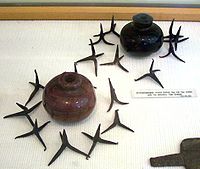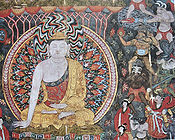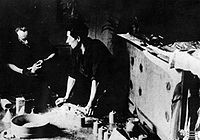
Grenade
Encyclopedia

Explosive device
An explosive device is device that relies on the exothermic reaction of an explosive material to provide an extremely sudden and violent release of energy. Explosive devices have applications as demolition devices and as weapons in the military....
that is projected a safe distance away by its user. Soldiers called grenadiers specialize in the use of grenades. The term hand grenade
Hand grenade
A hand grenade is any small bomb that can be thrown by hand. Hand grenades are classified into three categories, explosive grenades, chemical and gas grenades. Explosive grenades are the most commonly used in modern warfare, and are designed to detonate after impact or after a set amount of time...
refers any grenade designed to be hand thrown. Grenade Launcher
Grenade launcher
A grenade launcher or grenade discharger is a weapon that launches a grenade with more accuracy, higher velocity, and to greater distances than a soldier could throw it by hand....
s are firearms designed to fire explosive projectile grenades. There are both grenade launchers that are integrated into other weapons (such as service rifles) and those that are built as individual weapon systems.
Design
Most grenades explode, projecting fragmentsFragmentation (weaponry)
Fragmentation is the process by which the casing of an artillery shell, bomb, grenade, etc. is shattered by the detonating high explosive filling. The correct technical terminology for these casing pieces is fragments , although shards or splinters can be used for non-preformed fragments...
, i.e., pieces of the casing, serrated
Serration
Serration generally refers to a saw-like appearance or a row of sharp or tooth-like projections. A serrated cutting edge has many small points of contact with the material being cut. By having less contact area than a smooth blade or other edge, the applied force at each point of contact is...
wire, or an incendiary
Incendiary device
Incendiary weapons, incendiary devices or incendiary bombs are bombs designed to start fires or destroy sensitive equipment using materials such as napalm, thermite, chlorine trifluoride, or white phosphorus....
material. Some, such as smoke grenades, merely burn, releasing smoke for masking, marking, or signaling. CS
CS gas
2-chlorobenzalmalononitrile is the defining component of a "tear gas" commonly referred to as CS gas, which is used as a riot control agent...
riot grenades function the same way. Grenades contain an explosive or chemical filler and have a small opening for a fuse
Fuse (explosives)
In an explosive, pyrotechnic device or military munition, a fuse is the part of the device that initiates function. In common usage, the word fuse is used indiscriminately...
. In modern hand grenades, the fuse is lit by an internal device rather than an external flame.
Grenades are not reusable.
Detonation mechanism
PercussionA percussion grenade detonates upon impact with the target. Classic examples of percussion grenades are the British Gammon bomb
Gammon bomb
The Gammon bomb, officially known as the No. 82 grenade was a British hand grenade used during World War II.-Overview:Designed by Capt. R.S. Gammon MC of the 1st Parachute Regiment, the Gammon bomb was developed as a replacement for the temperamental and highly dangerous "sticky bomb" grenade...
and No 69 grenades which both used an "All-ways" impact fuse. Some percussion grenades have a conventional pyrotechnic fuse fitted as a backup detonation device.
Timed fuse
In a timed fuse grenade, the fuse is ignited upon release of the safety lever. Timed fuse grenades are generally preferred to hand-thrown percussion grenades because their fuzing mechanisms are safer and more robust than those used in percussion grenades. Air burst grenades are fired from launchers and explode after a preset time coinciding with the distance to the target.
Incendiary grenades

Petroleum
Petroleum or crude oil is a naturally occurring, flammable liquid consisting of a complex mixture of hydrocarbons of various molecular weights and other liquid organic compounds, that are found in geologic formations beneath the Earth's surface. Petroleum is recovered mostly through oil drilling...
, appeared in the Eastern Roman (Byzantine) Empire, not long after the reign of Leo III
Leo III the Isaurian
Leo III the Isaurian or the Syrian , was Byzantine emperor from 717 until his death in 741...
(717-741). Byzantine soldiers learned that Greek fire
Greek fire
Greek fire was an incendiary weapon used by the Byzantine Empire. The Byzantines typically used it in naval battles to great effect as it could continue burning while floating on water....
, a Byzantine invention of the previous century, could not only be thrown by flamethrower
Flamethrower
A flamethrower is a mechanical device designed to project a long controllable stream of fire.Some flamethrowers project a stream of ignited flammable liquid; some project a long gas flame. Most military flamethrowers use liquids, but commercial flamethrowers tend to use high-pressure propane and...
s at the enemy, but also in stone and ceramic jars. Later, glass containers were employed. Byzantine hand grenades with Greek fire in the 10th to 12th centuries are on display in the National Museum at Athens
Old Parliament House, Athens
The Old Parliament building at Stadiou Street in Athens, housed the Greek Parliament between 1875 and 1932. It now houses the country's National Historical Museum .-History:...
. The use of petroleum for incendiary weapons, or rather variants thereof, spread to Muslim armies in the Near East
Near East
The Near East is a geographical term that covers different countries for geographers, archeologists, and historians, on the one hand, and for political scientists, economists, and journalists, on the other...
, from where it reached China
China
Chinese civilization may refer to:* China for more general discussion of the country.* Chinese culture* Greater China, the transnational community of ethnic Chinese.* History of China* Sinosphere, the area historically affected by Chinese culture...
by the 10th century.
Some medieval petard
Petard
A petard was a small bomb used to blow up gates and walls when breaching fortifications. The term has a French origin and dates back to the sixteenth century...
s were small enough to be employed against enemy troops and be considered as primitive hand grenades
Explosive grenades

Gunpowder
Gunpowder, also known since in the late 19th century as black powder, was the first chemical explosive and the only one known until the mid 1800s. It is a mixture of sulfur, charcoal, and potassium nitrate - with the sulfur and charcoal acting as fuels, while the saltpeter works as an oxidizer...
in China, gunpowder was applied to create the world's first explosive grenades, a prototype of the modern hand grenade. Explosive grenades first appeared in Europe during the 17th century.
China
In China during the Song DynastySong Dynasty
The Song Dynasty was a ruling dynasty in China between 960 and 1279; it succeeded the Five Dynasties and Ten Kingdoms Period, and was followed by the Yuan Dynasty. It was the first government in world history to issue banknotes or paper money, and the first Chinese government to establish a...
(960–1279AD), weapons known as Zhen Tian Lei
Zhen Tian Lei
Zhen Tian Lei is an early type of hand grenade developed in 10th century China. Its shell was made of cast iron and filled with gunpowder. The length of the fuse could be adjusted according to the intended throwing distance....
were created when Chinese soldiers packed gunpowder
Gunpowder
Gunpowder, also known since in the late 19th century as black powder, was the first chemical explosive and the only one known until the mid 1800s. It is a mixture of sulfur, charcoal, and potassium nitrate - with the sulfur and charcoal acting as fuels, while the saltpeter works as an oxidizer...
into ceramic or metal containers. In 1044, a military book Wujing Zongyao
Wujing Zongyao
The Wujing Zongyao was a Chinese military compendium written in 1044 AD, during the Northern Song Dynasty. Its authors were the prominent scholars Zeng Gongliang , Ding Du , and Yang Weide , whose writing influenced many later Chinese military writers. The book covered a wide range of subjects,...
("Compilation of Military Classics") described various gunpowder recipes in which one can find, according to Joseph Needham
Joseph Needham
Noel Joseph Terence Montgomery Needham, CH, FRS, FBA , also known as Li Yuese , was a British scientist, historian and sinologist known for his scientific research and writing on the history of Chinese science. He was elected a fellow of the Royal Society in 1941, and as a fellow of the British...
, the prototype of the modern hand grenade.
The first cast iron
Cast iron
Cast iron is derived from pig iron, and while it usually refers to gray iron, it also identifies a large group of ferrous alloys which solidify with a eutectic. The color of a fractured surface can be used to identify an alloy. White cast iron is named after its white surface when fractured, due...
bombshells and grenades did not appear in Europe until 1467. Within a couple centuries of this, the Chinese had discovered the explosive potential of packing hollowed cannonball shells with gunpowder. Written later by Jiao Yu
Jiao Yu
Jiao Yu was a Chinese military officer loyal to Zhu Yuanzhang , the founder of the Ming Dynasty . He was entrusted by Emperor Hongwu as a leading artillery officer for the rebel army that overthrew the Mongol Yuan Dynasty, and established the Ming Dynasty...
(焦玉) in the mid 14th century book of the Huolongjing
Huolongjing
The Huolongjing is a 14th century military treatise that was compiled and edited by Jiao Yu and Liu Ji of the early Ming Dynasty in China...
(火龙经, "Fire Drake Manual"), this manuscript recorded an earlier Song-era cast iron cannon known as the "flying-cloud thunderclap cannon" (飞云霹雳炮; feiyun pili pao). The manuscript stated that (Needham's modified Wade-Giles
Wade-Giles
Wade–Giles , sometimes abbreviated Wade, is a romanization system for the Mandarin Chinese language. It developed from a system produced by Thomas Wade during the mid-19th century , and was given completed form with Herbert Giles' Chinese–English dictionary of 1892.Wade–Giles was the most...
spelling):
This text of the Huolongjing was also important for the understanding of the Chinese hand grenade in the 14th century, as it provided much more detailed descriptions and even printed illustrations of the grenade bombs used.

Europe
In 1643, it is possible that "Grenados" were thrown amongst the Welsh at Holt Bridge during the English Civil War. The word "grenade" originated in the Glorious RevolutionGlorious Revolution
The Glorious Revolution, also called the Revolution of 1688, is the overthrow of King James II of England by a union of English Parliamentarians with the Dutch stadtholder William III of Orange-Nassau...
(1688), where cricket ball-sized iron spheres packed with gunpowder and fitted with slow-burning wicks were first used against the Jacobites
Jacobitism
Jacobitism was the political movement in Britain dedicated to the restoration of the Stuart kings to the thrones of England, Scotland, later the Kingdom of Great Britain, and the Kingdom of Ireland...
in the battles of Killiecrankie
Battle of Killiecrankie
-References:*Reid, Stuart, The Battle of Kiellliecrankkie -External links:* *...
and Glen Shiel
Battle of Glen Shiel
The Battle of Glen Shiel was a battle in Glen Shiel, in the West Highlands of Scotland on 10 June 1719, between British government troops and an alliance of Jacobites and Spaniards, resulting in a victory for the government forces. It was the last close engagement of British and foreign troops on...
. These grenades were not very effective (probably because a direct hit would be necessary for the grenade to have effect) and, as a result, saw little use. However, trench warfare
Trench warfare
Trench warfare is a form of occupied fighting lines, consisting largely of trenches, in which troops are largely immune to the enemy's small arms fire and are substantially sheltered from artillery...
favored the grenade.
Etymology
The word "grenade" is the French word for pomegranate. Soldiers commented on the similar shape of early grenades and the name entered common usage.Other Information
1)Although Grenades have a hard shell, the shell is designed to be destroyed so it can project fragments made of casing, serrated wire, or incendiary materials, making it not reusable.2)The S Thunder Hand Held Grenade creates a sonic boom, making it mostly used for crowd control.

